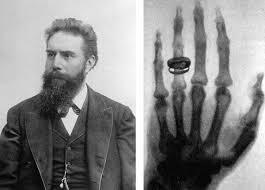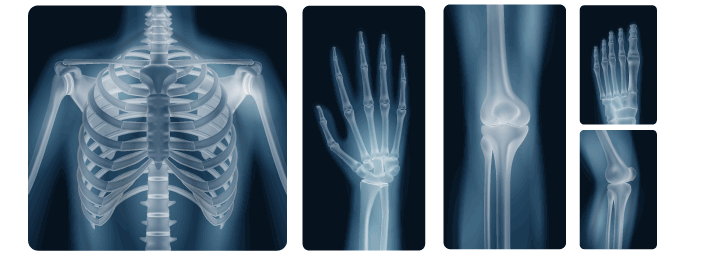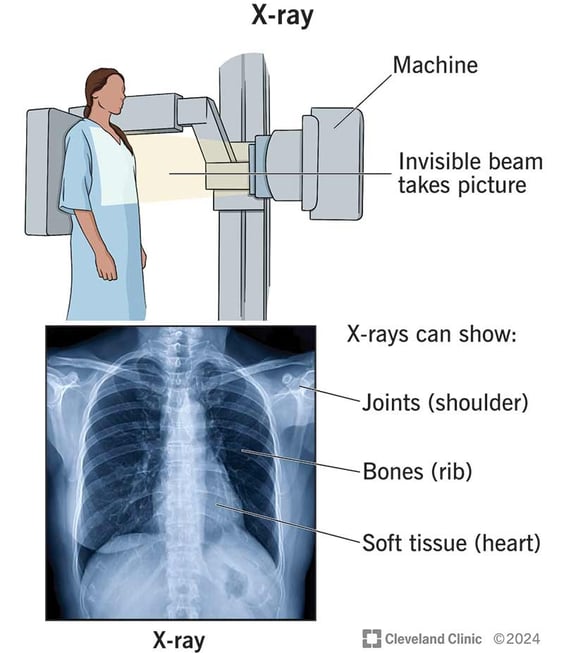Behind the Lens: The Science of X-Rays and Their Impact
X-rays have become an integral part of modern medicine, helping doctors diagnose a wide variety of conditions, from broken bones to life-threatening diseases. Yet, the science behind X-rays and their remarkable impact on healthcare is often taken for granted. In this blog, we’ll explore how X-rays work, their revolutionary applications, and the broader impact they've had on the world of medicine and beyond.
2/17/20254 min read


What Are X-Rays?
X-rays are a form of electromagnetic radiation, much like visible light, but with much higher energy levels. The key distinction is that X-rays have enough energy to pass through various materials, including the human body, which makes them ideal for medical imaging. When directed through the body, X-rays are absorbed by different tissues to varying degrees. Dense materials, like bones, absorb more radiation and appear white on X-ray films, while softer tissues, like muscles and organs, appear darker.
How Do X-Rays Work?
The process of taking an X-ray image involves sending a controlled beam of X-rays through the body, which are then absorbed by the tissues in the body. The X-rays that pass through the body hit a special detector or film on the other side, creating a shadow-like image. The differences in the absorption of X-rays by different body parts create a clear contrast, allowing healthcare professionals to view the internal structures of the body.
While traditional X-ray films were used for many years, modern technology now uses digital X-rays, which offer faster results and higher-quality images. These images can be stored electronically, making them easier to share and analyze.
Applications of X-Rays in Medicine
X-ray technology has revolutionized healthcare by providing a non-invasive way to observe the internal workings of the human body. Here are some of the major areas where X-rays are used:
Bone Fractures and Injuries
The most common use of X-rays is for detecting bone fractures and injuries. The contrast between bones and surrounding tissues makes fractures easily identifiable.Dental X-rays
Dentists use X-rays to detect cavities, check the health of the jawbone, and spot issues like impacted teeth or infections that are not visible to the naked eye.Chest X-rays
Chest X-rays are commonly used to diagnose conditions such as pneumonia, tuberculosis, and lung cancer. They can also help identify heart problems by showing the size and shape of the heart and lungs.Mammography
Mammography is a specific type of X-ray used to screen for breast cancer. It can detect tumors that are too small to be felt by a doctor or patient, allowing for early detection and treatment.CT Scans (Computed Tomography)
A CT scan is an advanced type of X-ray that takes cross-sectional images of the body. It’s commonly used to detect cancer, internal bleeding, and diseases affecting the brain, abdomen, or chest.Fluoroscopy
Fluoroscopy is a real-time X-ray imaging technique used in procedures like catheter insertion, gastrointestinal studies, and certain surgeries. It helps doctors monitor the movement of instruments or contrast agents inside the body.
The Impact of X-Rays on Medicine and Healthcare
The advent of X-ray technology has been nothing short of transformative for the medical field. Before X-rays, physicians had to rely on external physical exams and exploratory surgery to understand what was happening inside the body. The ability to “see” inside a patient’s body without cutting them open has saved countless lives and improved the accuracy of diagnoses.
Early Diagnosis and Treatment
X-rays allow for the early detection of diseases like cancer, osteoporosis, and infections, which increases the chances of successful treatment. Early diagnosis is critical because many diseases, such as breast cancer or lung cancer, are most treatable when caught in the earliest stages.Minimizing Risks and Invasive Procedures
Prior to X-rays, doctors often had to perform risky and invasive procedures, such as exploratory surgeries, to identify the cause of pain or illness. With X-ray imaging, many of these invasive procedures have been replaced by less risky and more efficient diagnostic methods.Advancements in Technology
Over time, the field of radiology has evolved with innovations like digital imaging, 3D imaging, and computer-assisted diagnostics. These advancements have not only improved the clarity and accuracy of images but also shortened the time needed to make diagnoses.
Beyond Healthcare: X-Rays in Other Industries
While X-rays are most commonly associated with healthcare, their applications extend beyond hospitals and clinics. X-ray technology has made its mark in industries such as security, manufacturing, and research:
Security
X-ray machines are used in airport security to scan luggage and check for dangerous or prohibited items. The ability to see inside bags without opening them has improved security processes globally.Material Testing
In manufacturing, X-rays are used for quality control and non-destructive testing. They can detect flaws, cracks, or weaknesses in materials like metals, plastics, and electronics without causing any damage.Archaeology and Research
X-rays have also found a place in research fields such as archaeology. Scientists use X-ray imaging to study ancient artifacts or fossils without damaging them, revealing hidden details that might otherwise remain unknown.
The Future of X-Ray Technology
X-ray technology is constantly evolving, with new advancements on the horizon. One of the most promising developments is the integration of artificial intelligence (AI) with X-ray imaging. AI-powered software can assist radiologists by analyzing X-ray images faster and more accurately, improving both diagnostic speed and precision.
Additionally, there are ongoing efforts to reduce the radiation exposure associated with X-ray procedures, making them safer for patients without compromising image quality.




Reference Website Link:
American College of Radiology (ACR)
https://www.acr.org/National Institute of Biomedical Imaging and Bioengineering (NIBIB)
https://www.nibib.nih.gov/Mayo Clinic – X-ray Overview
https://www.mayoclinic.org/tests-procedures/x-ray/about/pac-20384918Healthline – X-ray Procedure
https://www.healthline.com/health/x-ray
